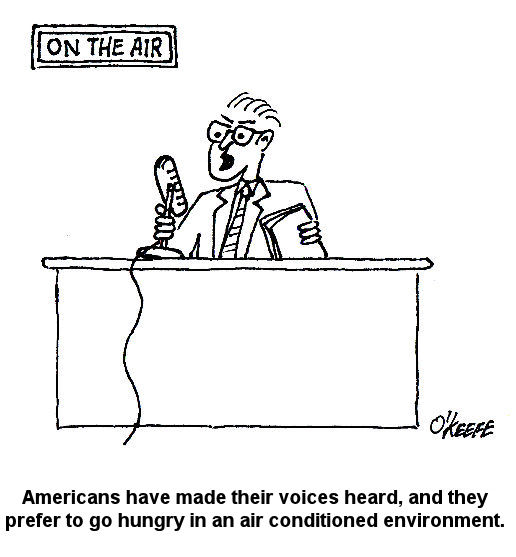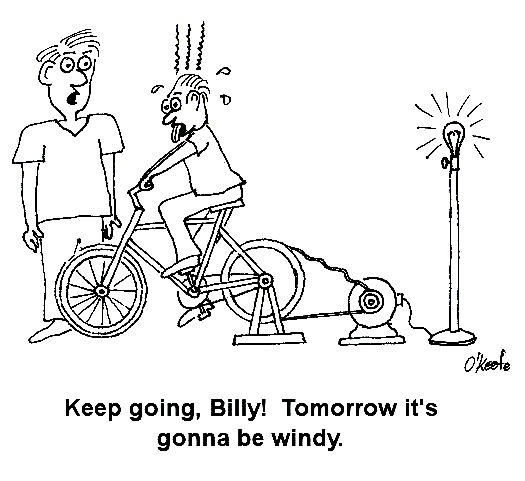|
The last few weeks we’ve been discussing some of the technical and environmental drawbacks of alternative sources of electrical energy and nuclear power generation. This week we’ll take a look at another drawback, that of energy sprawl.
So what exactly is “energy sprawl?” It’s an easily understand concept, but one that is often overlooked by proponents of the alternative energy movement. Energy sprawl is simply the amount of land which is taken over by alternative power sources in order to generate a given amount of electricity, and that number is dauntingly large.
For example, let’s revisit the subject of wind turbines. According to the National Renewable Energy Laboratory (NREL) of the U.S. Department of Energy, each turbine is to be spaced five to ten turbine diameters apart in a wind farm, depending on local conditions. Now the blades of a 2 megawatt (2 million watt) wind turbine are about 260 feet in diameter, and for our example we’ll space them at the prescribed minimum distance of five diameters. The math for this one is easy, 260 times five, which equates to spacing of 1333 feet, or just over a quarter of a mile. That’s right, if you build a wind turbine farm with a whole bunch of these 2 megawatt turbines, they’ll have to be spaced a minimum of a quarter mile apart. You’ll need a lot of acreage.
So based on the calculations above, we’d have to build a wind farm where each 2 megawatt turbine is surrounded by a circle of empty land 1333 feet in radius. We know from geometry that the area of a circle can be calculated by multiplying pi, that is 3.1416, times its radius squared, and this translates into a minimum area of about 5.6 million square feet per 2 megawatts of power generated, or about 2.8 million square feet per megawatt. Just to put this into perspective, a football field has an area of 57,564 square feet. So what we’re actually talking about here is a little more than 48 football fields worth of land per megawatt of electricity generated!
Let’s turn our attention now to solar power generation. We want to generate electricity with their photo-voltaic (PV) panels, and these panels are made of special materials that convert the sun’s energy directly into electricity. Great concept, but here again we’re talking a lot of land. According to the NREL, it’s estimated that 6.4 acres are required to generate 1 megawatt of electricity using PV panels. Since one acre equals 43,560 square feet, we’d need a total of 278,784 square feet of land area per megawatt. After we’ve done the math we discover that this equates to almost five football fields of area per megawatt of electricity generated.
We’ve now established that loads of land space is required to operate multiple options for alternative energy, and you’re probably wondering how this all compares to land usage for fossil fuel (i.e. coal, oil, natural gas) and nuclear power generation. Well, a typical 1000 megawatt coal fired power plant occupies about 148 million square feet. This translates to around 148,000 square feet per megawatt, which is just over two and a half football fields per megawatt. As for a 1000 megawatt nuclear power plant, we’re talking about 28 million square feet that’s typically occupied by an operating plant, and that translates to almost 28,000 square feet per megawatt, or a little less than half of a football field per megawatt.
Math established, it’s a hands down victory for fossil fuel and nuclear plants compared to wind turbine and solar energies when it comes to land usage. Last time I checked tillable land acreage was going down, not up, around cities where electricity demand is highest. Do we start pushing farther outward to build wind turbine and PV farms on vast expanses of land currently occupied by forests or used to grow our food? Which would you rather do, eat or have electricity?
_____________________________________________
|
Posts Tagged ‘wind farm’
Alternative Energy Sprawl
Sunday, May 2nd, 2010Alternative Energy And Its Impact On Our Electrical Grids
Sunday, April 11th, 2010|
This week’s blog is a re–publication of a web article by Alex Salkever which appeared on April 6, 2010, in Daily Finance, an AOL Money and Finance site. It’s an excellent followup to last week’s blog on wind turbine energy, which raised concerns as to the feasibility of its widespread use. It’s always good to have multiple sources of information when assessing the value of anything, such as when you seek a doctor’s second opinion, and this article serves that purpose. Enjoy! Too Green, Too Soon? Renewable Power May Destabilize Electrical Grid By Alex Salkever Boy, that was fast. Only five years into the world’s renewable energy push, many utility companies are so concerned about grid instability that they’re saying they can’t accept any more electricity from intermittent sources of power. Translation: Solar power only runs in the day time and can’t re relied on for so called “baseload” capacity. Wind power primarily produces current at night and, likewise, can’t be relied upon for baseload capacity. Geothermal, meanwhile, is perfect for providing baseload. But geothermal projects take an excruciatingly long time to build out. And then there have been the recent spate of earthquake scares around geothermal sites. The upshot: Utilities such as Hawaiian Electric in President Obama’s home state are voicing concerns about plans to integrate more solar and wind power into the grid until they develop methods to more effectively absorb intermittent sources of power without destabilizing the whole shebang. In Europe, Czech utility companies are concerned that “feed-in tariffs,” which require power companies to repurchase all home- and business-generated renewable power at elevated rates, might wreak havoc on the Central European grid. This growing push-back from utilities could prove to be shock to energy project developers, lawmakers and homeowners. In the U.S., project developers and state lawmakers have assumed that the ambitious laws mandating as much as 40% of some states’ power come from renewable sources within the next few decades would ensure huge demand for green power as utilities scaled up their use of such resources from low single-digit levels. Likewise, homeowners have tended to assume that if they could put a panel on their roof (or a windmill on their property), they would be guaranteed a market for the extra power produced. Storing Excess Power in Ice, Salt or Even … Caves? The ability to sell back power to a utility at retail rates (meaning the rates they charge the public) is dubbed “net metering,” and many states have limitations on what percentage of total baseload power on a grid a utility must buy back. It was broadly assumed net metering would go away in hurry when the Green Revolution came of age. Now, that appears unlikely. The alleged problems with absorbing intermittent green power point to a more fundamental issue with the existing power grid — namely, that the system isn’t really ready to handle a significantly more distributed power production footprint. One possible remedy would be for utilities to build more power storage systems, and many new forms for those are on the drawing boards. One solution could be massive battery installations from the likes of A123 Systems. Another could be a system such as that offered by Ice Energy, which uses cheap power at night to make ice, reducing the power requirements of air conditioning systems in the daytime. This effectively arbitrages the price differential between nighttime and daytime power generation — something that potentially could be a huge boon for wind power. Other, more exotic “battery” systems that have been proposed include storing power in molten salt or injecting compressed air into sealed caves, both of which create potential energy that can later be used to power electric generators. Power storage is already being recognized as essential to new renewable energy projects. A wind farm on Maui will be the first in the country to have an added power storage component in the form of a bank of lithium-ion batteries. But most green power developers are still having trouble competing with coal and natural gas fired plants on a level playing field — even without adding in the costs of power storage. If the issues of dealing with intermittent power sources are as disruptive to grid stability as some traditional utilities are claiming, the Green Revolution may be a case of “too much, too soon” — at least until the engineers can figure out better, cheaper ways to capture sunshine and wind in a bottle. From DailyFinance: http://srph.it/dAoxAj _________________________________________________________________ |





